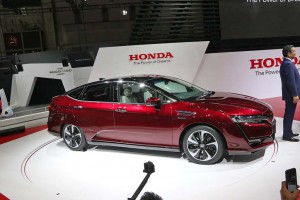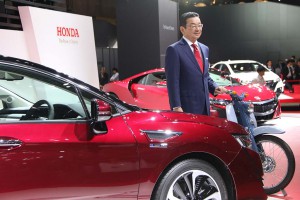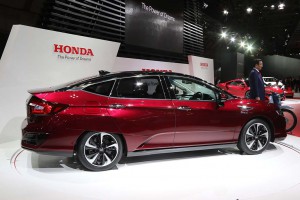
The 2016 Honda Clarity fuel cell vehicle will be available soon in Japan, but on a lease-only basis in the U.S. next spring.
Don’t be surprised if you get a slight sense of déjà vu when someone mentions Honda’s new hydrogen car. The Japanese maker has decided to call it the Clarity, the same name it used for its original fuel-cell vehicle nearly a decade ago.
After delaying the hydrogen car project for about a year, Honda finally introduced the production model at the Tokyo Motor Show on Wednesday. It will soon go on sale in the maker’s home market and reach the U.S. by spring – or, more precisely, Southern California, about the only place where the gaseous fuel is readily available.
In Japan, the Honda Clarity will go for 7.6 million yen, or roughly US$64,000, but the price is likely to be discounted in the States where Clarity will be offered “exclusively for lease,” the maker said, at $499 a month.
Fuel-cell vehicles combine hydrogen and oxygen in a device called a “stack,” creating water vapor and a stream of current that can run the same electric motors as a battery car. In fact, some proponents like to call a fuel-cell system a “refillable battery.” The Honda Clarity’s high-pressure tanks will hold enough hydrogen to give the sedan a range of more than 435 miles, the maker claims.

Honda Chief Executive Officer Takahiro Hachigo introduced the new Clarity FCV which carries its green nature to extremes: even its name is recycled!
And then, the maker said in a statement, “The tank can be refilled in approximately three minutes, realizing the ease of use equivalent to that of a gasoline-powered vehicle.”
That is, of course, if they can find a hydrogen filling station. There are barely two dozen in the entire U.S., most in Southern California. That state has set aside a special fund to expand the count to more than 100 by decade’s end. Meanwhile, a consortium of automakers, including Toyota and Nissan, as well as Honda, has teamed up with the Japanese government to set up stations across the country. Germany has authorized a similar hydrogen-refueling network.
(Toyota dealers taking orders for Mirai fuel-cell vehicles. For more, Click Here.)
That could help encourage motorists looking for an alternative to battery-electric vehicles, advocates contend.
Honda claims it has made a significant number of improvements since offering the original FCX Clarity for sale in 2008. It uses a much smaller, and yet more powerful, fuel-cell stack. It can operate under a wider temperature range. And it is much more efficient.
“The fuel cell stack for this model was downsized by 33% compared to the previous version,” Honda explained, “and yet output of more than 100kW (was) achieved,” or 134 horsepower. “The fuel cell powertrain was made as compact as a V-6 engine,” Honda added, making it possible to fit the entire system under the hood of a conventional vehicle for the first time.
The system has another advantage, the maker claims, the ability to serve as a mobile power generator at, say, a campground or an emergency site.
(Click Here for the dozen biggest debuts at the Tokyo Motor Show.)
Honda will become the third automaker to market a fuel-cell vehicle to retail buyers. Hyundai launched a version of its Tucson SUV a year ago. Toyota is just rolling out its new Mirai model.
The Honda Clarity is almost exactly the same length as the Toyota Mirai, at 192 inches, though it’s lower and wider. However, it’s nearly 1 million yen, or about US$6,500, more expensive in Japan.
Both vehicles are expected to get a bit more than 300 miles in real-world driving in the U.S., a fair bit less than the 435 mile range Honda claims for the Clarity in Japan.
The market for fuel-cell vehicles is likely to become more crowded in the not-too-distant future. Mercedes-Benz is testing a hydrogen-powered version of its B-Class model in California. And other manufacturers, including General Motors, Nissan and BMW, are also working with the technology. In fact, a number of makers are showing fuel-cell prototypes at this year’s Tokyo Motor Show.
(To see more about why green car buyers pay with “green,” Click Here.)
Not everyone is convinced buyers will opt in. Elon Musk, founder and CEO of Tesla Motors, calls the technology “fool cells.” But proponents of hydrogen power insist the technology is the real, long-term solution, able to overcome the issues – like range and charging times – that have made battery-cars a hard sell.


Buying a battery powered EV is for fools as they will be obsolete toys in just a few years. Musk bet on the wrong tech and now he’ll either need to change and admit he was wrong or lose his car company. Based on consumer reviews of the tesla S Tesla’s demise may come before model 3 ever hits the streets. More than likely a lot of gamblers are going to lose their money.
GT, I also am skeptical, but I wouldn’t be shorting the stock yet, if I were you. Let’s watch the Model S sales trends through mid-2016 before we write this obituary.
Paul E.
Stock price generally has nothing to do with reality. At one time it was based on a companies financial results but that’s been gone for decades. In many cases stock price is strictly gambling and manipulation of the naïve. It won’t take too many years before Tesla either changes it’s business model or dies. Loosing $4K or more per model S sold is a good means to go broke quickly especially with owner and independent reviews highlighting the many model S defects.